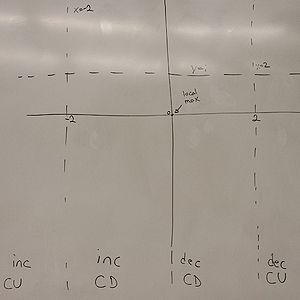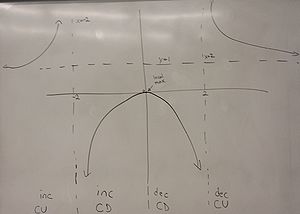Science:Math Exam Resources/Courses/MATH104/December 2013/Question 02 (g)
{{#incat:MER QGQ flag|{{#incat:MER QGH flag|{{#incat:MER QGS flag|}}}}}}
• Q1 (a) • Q1 (b) • Q1 (c) • Q1 (d) • Q1 (e) • Q1 (f) • Q1 (g) • Q1 (h) • Q1 (i) • Q1 (j) • Q1 (k) • Q1 (l) • Q1 (m) • Q1 (n) • Q2 (a) • Q2 (b) • Q2 (c) • Q2 (d) • Q2 (e) • Q2 (f) • Q2 (g) • Q3 • Q4 • Q5 • Q6 (a) • Q6 (b) • Q6 (c) •
Question 02 (g) |
|---|
|
Consider the function Its first and second derivatives are given by g) Draw the graph of f(x). Accurately place all critical points and inflection points, indicate all asymptotes, and make sure your graph correctly shows where f(x) is increasing and decreasing and correctly shows its concavity. |
|
Make sure you understand the problem fully: What is the question asking you to do? Are there specific conditions or constraints that you should take note of? How will you know if your answer is correct from your work only? Can you rephrase the question in your own words in a way that makes sense to you? |
|
If you are stuck, check the hint below. Consider it for a while. Does it give you a new idea on how to approach the problem? If so, try it! |
Hint |
|---|
|
Start by collecting all the information from the previous parts onto one graph. Then graph. |
|
Checking a solution serves two purposes: helping you if, after having used the hint, you still are stuck on the problem; or if you have solved the problem and would like to check your work.
|
Solution |
|---|
|
We draw where our function is increasing, decreasing, concave up, concave down as well as the only local extrema we found on a graph. We also include the asymptotes.
|
{{#incat:MER CT flag||
}}




